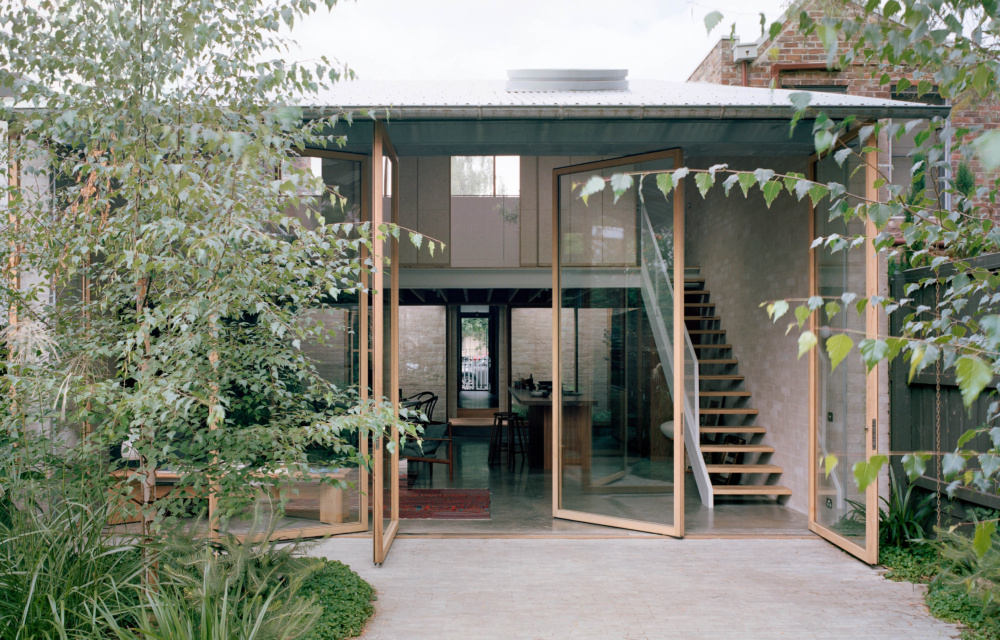How An Architect Couple Created Their Clever + Adaptable Family Cottage
Architecture
Carlton Cottage is the family home of the principal architects behind Lovell Burton.
The backyard opens to the rear laneway, which has become a place for the kids to play.
The new living pavilion is topped with a skillion roof.
Recycled bricks from demolished additions on the site have been used in the new walls.
The view from the adaptable living spaces towards the original worker’s cottage, separated by a courtyard.
The glass pivot doors allow for seamless indoor-outdoor connection.
Beyond the kitchen and bathrooms, the floor plan was designed with only ‘loose’ functions in mind.
The kitchen is neatly tucked below the mezzanine.
The island bench with a cooktop allows for interaction while meals are being prepared.
The courtyard helps draw natural light into the centre of the inner-city block.
One bathroom is located upstairs in the mezzanine and another in the original cottage.
An arched walkway marks the transition into the new addition.
The unassuming facade also encourages interaction with the street.
Lovell Burton principal architects Stephanie Burton and Joseph Lovell were first drawn to this Carlton workers’ cottage not for its built form — ‘although it did have a certain charm’ — but as an opportunity to embrace a walkable lifestyle.
‘Our eldest was about to start primary school, and being immersed in this community was important to how our family functions on many levels,’ Stephanie says.
Built in the 1870s, the house itself had fallen into a state of disrepair after many modifications over the years, leading to an ad-hoc arrangement of additions between the original dwelling and outhouse.
‘Not knowing how our life would evolve with young kids moving into teens and adulthood, we began with this idea of “loose fit, long life,”’ Stephanie notes of their self-imposed brief.
‘For us, this was about loosely demarcating space as a way of imbedding flexibility into the design that could adapt with our family through the seasonal patterns that occur over the year, but also in the longer term as the family evolves.’
Removing the series of existing lean-to structures made way for a ‘patchwork’ of multi-purpose spaces, with a special focus on improving ventilation, natural light, and social connection.
At the front of the cottage, the original four-room footprint was retained, which currently serve as bedrooms, a study, and a bathroom.
A courtyard with a walkway leading into the new living pavilion, with a kitchen below and an open mezzanine level above — used for sleeping, a secondary retreat, or anything else the family may need when their children become teenagers.
A series of 3.2-metre-tall pivot glass doors and a the large skillion roof creates a soaring internal volume, capturing sunlight and garden views from both ends of the addition.
The rustic walls feature recycled bricks from the site’s demolished structures, and joinery elements are sparse through the project, and conceived as flexible pieces of furniture that can be moved and adapted to suit potential future uses.
The rear carport was removed and replaced with an outdoor dining space, and large sliding gate that opens the site to the rear laneway.
It was the first time the architects have completed a project for themselves, and the greatest challenge was ultimately to combine their ideas on ‘what constitutes a home’ and decide what was important to them as a family.
‘The reworking of the cottage has refocused the home to engage outwardly into the immediate community,’ Stephanie says.
‘Veranda spaces to the front and rear, coupled with permeable fence details encourage our family to utilise the street and laneways as an extension of our living space.’
Just as many Carlton locals often spill out onto central nature strips on a sunny day, now, this cottage fosters fun moments of connection both amongst the family, and with their wider neighbourhood.

